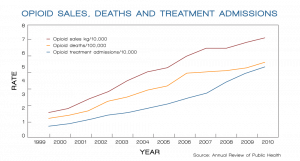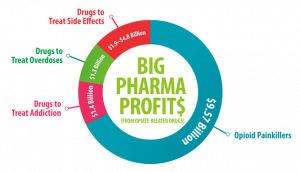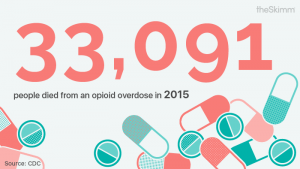In modern society countless foods and beverages are sold ‘over the counter’ in supermarkets, convenience stores and drugstores that contain traces of antibiotics as well as growth hormones.
A vast array of chemical additives is also used to extend shelf life, enhance taste and flavor stability and packaged-food aroma. The mixture of profit motives involving chemical additive manufacturers and food processors quickly reaches beyond the grasp of this post and the assignment it is based upon, so our primary focus will be upon the axis of ‘advertised absence of growth hormones and antibiotics versus non-advertised presence of these drugs’ with the aim of expanding awareness of the need for advertised presence in foods and beverages.
Many scientific studies over the past two decades 8,9 have revealed known harm and as-yet-uncatalogued-risks to human health by antibiotics and growth hormones.
Many over-the-counter foods – from store-endorsed and branded meats, poultry and dairy products sold through Safeway and Fred Meyer (et. al.) to branded fast food merchandised by McDonald’s, KFC, Dairy Queen and Burger King (etc.) contain these antibiotics and growth hormones, but reveal nothing about them in product presentations, whether in advertising appearing in newspaper supplements or on highly regulated food packaging which is required to reveal to consumers what they are buying and eating. Thus, while the absence of many chemicals and trace hormones and antibiotics is now aggressively promoted on food labels and store advertising in newspapers, widely presented as ‘organic’ and ‘free of preservatives’ and ‘no antibiotics or growth hormones’ ‘no GM of source products and feed’ and the like, the presence (but not quantity) of chemical additives is required to be revealed on package labels, but trace growth hormones and antibiotics fed to animals or introduced by inoculation of animals are not disclosed either in advertising or on package labels when lab analysis reveals they are present.
In the price-promotion advertisement below, taken from a Safeway Stores discount page printed and distributed through a local newspaper, the only data provided beyond ‘USDA Choice’ or other quality rating, which permits this T-bone beefsteak to be compared to steaks from other sources, is price.
The oversize white letters in the red box stating $5.77 per lb. along with the banner ‘USDA choice’ label is designed to promote a purchase decision almost entirely on the basis of price. Further inquiry into the meaning of ‘USDA choice’ reveals little beyond fat content and standards of handling, refrigeration and time-to-market measures – nothing at all about what the animals are fed, what inoculations they have routinely been given in what quantities, and what chemical additives have been introduced to retard decay, sustain (or add to) hydration, add appealing color or to enhance or sustain natural taste.
Thus, it is the principal purpose of this post to showcase a vast distinction between advertising, POS promotion and packaging which is required to reveal specified measures of food features such as saturated and unsaturated fat, sodium, carbohydrates and protein, but not required to reveal to important health risks of food content, both derived from animals fed an inoculated prior to harvest and market, and through additives introduced during processing.
By only mentioning the price and not important quality and purity features, the advertising passively conceals potentially harmful properties of the product, thus denying consumers information that would make them aware at least of potential risks, and concealing the presence by omission of adulterating trace drugs and chemicals. This concealment-by-omission not only denies the buyer important information, but also suggests by omission that it is not important, since buyers are today are accustomed to receiving a great deal of product information related to health and detailed product content, prior to and at the time of purchase.
The standard for advertising and product packaging, unless information is specifically required to include traces of feed and medicines used during animal breeding and farming, the information can be omitted. T-bone beefsteak which also contains trace antibiotics and growth hormones is ‘T-Bone Steak’.
In Contrast
Increasingly, a rival food merchandising organization (supermarket), Fred Meyer, has dedicated an increasing share of foodstore floor-and-shelf space to ‘natural’ and ‘organic foods.’ First one aisle, then two, now four aisles in each of their stores here in Bellingham.
Here we see examples of three packages featuring important affirmative notices of exclusions:
[ Simple Truth eggs photo ] [ Simple Truth Waffles ] [ Simple Truth Egg White ]
no growth hormones, no antibiotics free of preservatives from hens raised in an a humane environment with organic feed-source8 –
Increasingly, we see ‘natural’ and ‘organic’ food products offered and promoted in mainstream food stores, not only ‘health food markets’ which began to take hold in the 1960s. Today we have a mainstream populated by brands and stores that provide product information they are legally required to provide. What they provide today is dramatically more than what was required only a decade ago. The ‘pull-along’ effect of the natural and organic foods, whose producers use affirmative information of what their products do not contain, will eventually influence legislation which requires mainstream producers to include equivalent information, and to remedy the contents of their products so that the affirmative truth is an integral component of their appeal.
It is almost universal today that trans fats are in many states, simply banned – no food products can be offered for sale which contain them. And as label laws require reporting wherever they are still allowed, producers are gradually forced to eliminate them. Imagine the effect on sales of fish or seafood if law required a newspaper promotion to report that growth hormones or antibiotics had been used to assist the farming of ‘salmon’ or ‘trout’ or ‘shrimp’ along with a price promotion. Very quickly, either promotions would disappear or the use of the drugs and adulterants would cease. The wheels of change grind slowly, but they do roll on!
Background
Antibiotics are used in rearing farm animals for two essential purposes: (1) to prevent disease which can harm the animals, spread quickly through herds and flocks, or render meat and dairy products unsalable because of disease traces they are found to contain during USDA inspections, and (2) through a variety of animal husbandry methods involving elimination of microbial strains, to actively promote growth of the animals.
Antibiotics are medicines typically used to treat a wide variety of infections or diseases caused by bacteria. They do so by stopping growth and reproduction of bacteria; but not only harmful bacteria. Antibiotics also attack, and often eliminate, healthy bacteria in the human body, thus detracting from functions that aid health and natural body processes (example: lactobacillus that aids digestive processes in the intestine -source1 ) It is also now documented that antibiotics, through complex microbial and cell processes, promote growth in humans as well as animals, so that animals administered these drugs can pass growth-promoting drugs to humans who consume their flesh which contains residual amounts of the drugs consumed by the animals in feed or administered to them through inoculation against disease.
Although keeping the animals protected against disease, antibiotics passed through food also promote development of increasingly drug-resistant bacteria in the animals and humans who eat their flesh. Staphylococcus aureus, Streptococcus pyogenes and Mycobacterium are particularly dangerous ‘superbugs’ whose populations are promoted through widespread use of antibiotics in food and medicines. The newly developed antibiotic-resistant bacteria will then no longer ‘respond to’ antibiotics (stop growth and die) that have worked in the past. According to the Journal of American Medical Association, long term/ frequent consumption of antibiotics result in even common infections becoming more difficult to treat. Patients required extended hospital stays, where many dangerous pathogens flourish, and the spread of these resistant bacteria is increasingly threaten human communities.-source2-
Antibiotic also risk of numerous side-effects such as an upset stomach, nausea, diarrhea. Such conditions cause stress and thus reduce the strength of the body’s natural immune system, increasing vulnerability to disease. In more severe situations, antibiotics cause allergic reactions, such as rash, swelling of the face and tongue. Symptoms such as difficulty breathing, even hives and wheezing to anaphylactic shock can occur within an hour of taking antibiotics.-source3-
Currently, antibiotics can be used to treat animal/ food products, without the need to show percentage and precise trace quantities of antibiotics a meat, dairy or poultry product contains.
Because the FD does not require food producers or sellers to show traces in advertising, packaging or labeling, this information is not made available to consumers according to source or brand. The FDA has also approved antibiotics to be used for production purposes, such as to enhance growth or improve feed efficiency despite research showing that it will spur drug-resistance among bacteria(source4). Producing and selling organizations are thus allowed to incorporate antibiotics in widely distributed foods sold ‘over-the-counter’ that could cause significant harm to consumers without their knowledge of what their food contains and what its unrevealed contents are doing to their bodies.
Another aspect of foods that are not mentioned in advertisements are how companies manipulate growth hormones in animals such as cows and salmon. They do so by increasing the insulin-like growth factor (IGF), which mimics effects of human growth hormones in a harmful manner. -Source 5- growth hormones originate from the pituitary gland in normal circumstances– spurring growth in children and teenagers as well as helping to regulate body composition, body fluids, muscle and bone growth, body metabolism, and heart function. -source6- These artificial growth hormones which are not naturally produced by the pituitary gland promote a host of harmful effects, such as early puberty, excessive weight gain, as well as decreasing estrogen production for women in menopause, significantly affecting their health for years to come.
U.S. courts are moving gradually but steadily towards elimination of ‘false advertising’ (both what is claimed, and what is not revealed) regarding products of animals that have been mutated so much with the help of growth hormones and antibiotics that they are no longer considered the named species.
An example is shown in the case of so-called Kentucky Fried Chicken — where ‘chickens’ are kept alive by tubes being inserted into their bodies, pumping the supply of blood and nutrients throughout their structure. These grotesque ‘chickens’ have no beaks, no feathers, and no feet. Their bone structure is dramatically shrunk to get more meat from each systematic ‘creature.’ These so-called ‘chickens’ have been mutated to the point the KFC is no longer legally permitted to use the word ‘chicken’ on wall or table menus, or in commercial advertising.-source7- They can say ‘crispy KFC sandwich’ but they are not, in a triumph for truth in advertising, permitted to call the item a chicken sandwich.
I would not only not recommend this particular product to a family member or friend, but I would strongly discourage buying any food, soup or beverage product that doesn’t clearly state on the packaging that it doesn’t contain any antibiotic or growth hormones. I would make this suggestion because foods that don’t clearly state what they do not contain, frequently contain traces of antibiotics and growth hormones, which in return can be highly harmful and have a negative health impact on every individual who consumes the product, albeit it over a period of time that does not permit immediate perception of the negative effects.
While purchasing any food products, I would recommend first researching the brand and history of the product, ensuring there aren’t traces of antibiotics and growth hormones before consuming it.
Food Producers, Food Distributors and Food Merchandising Companies
An inescapable requirement is that this blog post include a ‘history of the company that is marketing the product.’
In the U.S. today, there are still millions of companies whose business purpose and profit is based upon harvesting, growing, synthesizing, transporting, distribution and selling food products.
These industries are too vast and numerous to characterize or describe, except, as treated in this post, as a group of industries and organizations as a class. They deliver food, and whether we are talking about the dangers of red dye #2 or the effects on health of growth hormone 51 or the medical side-effects and long-term growth and drug-resistance effects of geo-thermo-heptomycin, the revelation to be shared by this post is as follows:
If it is against the law, and punishable by fines exceeding the available profit, from any venture based upon food product, distribution or marketing, or by imprisonment, to offer food for sale whose sources, derivation, content or additives are not made
freely available to the buyer, the producer or seller will not make the information available. A ‘race to the top’ in a competitive market will never be sufficient for information to be sufficient for safety and fully shared. It costs money to collect, verify, report, submit for inspection, and so forth. Sharing it is also costly, whether this is done through printing in advertising, on a label or as part of an oral or video presentation.
Standards of adequacy for these information activities will require thousands of lawyers and marketing professionals, judges and legislators, government regulators and agents to enforce, to advance to where public health and commercial fairness are fully served.
As long ago as 1911, when Upton Sinclair Lewis reported in The Jungle12 the deplorable and dangerous lack of health standards in the U.S. meat processing industry, the struggle to provide accurate and comprehensive information about our food supplies has been resisted by farmers and producers, not always because they want to hide the truth, but because it is expensive to develop, expensive to advertise, expensive to verify, expensive to police the information provided.
In the narrow scope of this post, concerned with the widespread adulteration of food with trace growth hormones and antibiotics, until recently used almost universally in animal husbandry, we might as a takeaway note the contrast between what is not revealed in advertising and packaging of mainstream meat, dairy and poultry products, and (in passing) the chemical additives used to
improve shelf life and the visual-and-taste appeals of food products; versus what is, increasingly, revealed by ‘certified organic’, ‘hormone free’, ‘antibiotic free’ and ‘preservative and dye-free’ products, to the consumers who purchase and consume them.
The affirmative process of telling consumers what food products do not contain is not enough. We need to be told in plainly stated and available language, what each food product contains.
The costs to do this are high. Buying behavior has shown that a great swath of the consuming marketplace is more concerned with taste, texture and price than with health. The gradually evolving solution, therefore, depends upon education first by those who lead, and eventually, legally mandated compliance, by those who follow.
Sources:
-(1)http://kidshealth.org/en/parents/antibiotic-overuse.html
-(2) https://www.livestrong.com/article/203530-side-effects-of-long-term-antibiotic-use/
-(3)https://www.healthdirect.gov.au/allergic-reactions-to-antibiotics
-(4)https://www.fda.gov/animalveterinary/guidancecomplianceenforcement/guidanceforindustry/ucm216939.htm
-(5)http://www.health.com/health/article/0,,20458816,00.html
(6)https://www.webmd.com/fitness-exercise/human-growth-hormone-hgh#1
-(7) https://www.snopes.com/food/tainted/kfc.asp
-(8) -(9)Blaser, Martin J. MD, Missing Microbes, Henry Holt and Company, 2014
– (10) Yong, Ed, I Contain Multitudes, The Microbes Within Us and a Grander View of Life
-(11) Finlay, B. Brett and Arrieta, Marie-Claire, Let Them Eat Dirt: How Microbes Can Make Your Child Healthier, Algonquin Books of Chapel Hill, 2017
-(12) The Bugs That Live on Us and Around Us, Amanda Shaeffer, The New Yorker, March 18, 2016
-(13) Upton Sinclair, The Jungle, 1905, https://fee.org/articles/29-upton-sinclairs-the-jungle-proved-regulation-was-required/
-(14) Germs Are Us, Michael Specter, The New Yorker, October 15, 2012



















